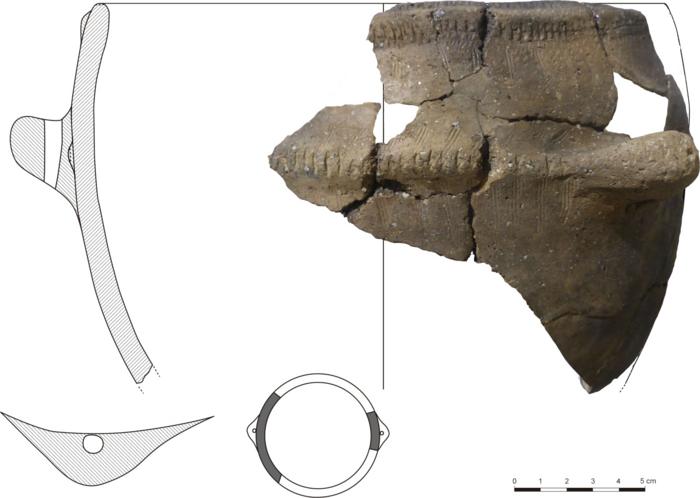The analysis of the content and use of prehistoric vessels has become a valuable source of information on the food patterns and subsistence practices of past societies. A research conducted on the materials found at the Huescan sites of Cueva de Chaves (Bastaràs), at 640 metres above sea level, and at Espluga de la Puyascada (La Fueva), at 1,300 metres above sea level, in a strictly Pyrenean mountain region, now has yielded the first direct evidence of dairy product consumption and processing in the Pyrenees during the earliest stages of the Neolithic.

Credit: R. Laborda
The analysis of the content and use of prehistoric vessels has become a valuable source of information on the food patterns and subsistence practices of past societies. A research conducted on the materials found at the Huescan sites of Cueva de Chaves (Bastaràs), at 640 metres above sea level, and at Espluga de la Puyascada (La Fueva), at 1,300 metres above sea level, in a strictly Pyrenean mountain region, now has yielded the first direct evidence of dairy product consumption and processing in the Pyrenees during the earliest stages of the Neolithic.
The study was conducted by prehistorians from the Universitat Autònoma de Barcelona (UAB) and the University of Zaragoza, and chemists from the University of Strasbourg, France, on materials on display at the Huesca Museum. The findings have now been published in the journal Archaeological and Anthropological Sciences.
The research was conducted through a combination of techniques used to identify organic residues and the isotopic characterisation of fatty acids to determine animal origin, as well as data obtained of the morphology and functionality of ceramics and the archaeozoological studies of both sites.
The analysis of organic residues preserved in the argillaceous matrix of the interior of 36 ceramic vessels indicates that 7,500 years ago dairy products were already processed and consumed in the Central Pyrenees. The correlation between the residues of dairy fats and the different forms of the pottery suggests, moreover, that all the processes (preparation, consumption and storage) were carried out in both settlements.
This “questions previous considerations in which dairy consumption in the Pyrenees was thought to have begun much later”, points out Nàdia Tarifa, researcher from the University of Strasbourg when this study was conducted, and lead autor of the paper. “It was always thought that prehistoric social dynamics in mountainous regions were slower or ‘less evolved’ than in coastal regions. Our study adds solid proof to previous faunistic studies conducted in both sites, which had pointed to dairy farming in these mountainous regions at the very early stages of the Neolithic period”, Tarifa states.
The study also shows how pig-derived products may have been processed or stored in ceramic vessels at both sites, which would indicate the importance of this species for the early mountain farming economies. In contrast to the results for milk, researchers also observed variations between the two sites in terms of the exploitation of meat from ruminants and pigs, with a predominance of the former in Espluga de la Puyascada and the latter in Cueva de Chaves. These differences could be related to the characteristics of the settlements and their surroundings, and to the methods of meat processing.
The researchers also identified residues from processed vegetables, as well as from pine resin. The latter substance would have been used to waterproof the inside of the vessels.
The results support the idea that in the early Neolithic period in the Pyrenean area there was a mixed economy based on integrated agriculture and livestock farming (in which one supported the other), with sheep herds as the main source of meat and milk.
“Our findings provide a better understanding of consumption habits and the technological use of resources in the early Neolithic period in the Pyrenees and open up new avenues of research to deepen our understanding of the social and economic dynamics of ancient societies, especially in mountainous areas”, says Alejandro Sierra, researcher at the UAB and co-author of the study.
Journal
Archaeological and Anthropological Sciences
Method of Research
Experimental study
Subject of Research
Not applicable
Article Title
Milk production in pottery. Evidence for various exploited resources used by the first farmers in Central Pyrenees using the morphological, chemical and stable carbon isotopic composition of organic residues from ceramic vessels
Article Publication Date
11-Jun-2024



